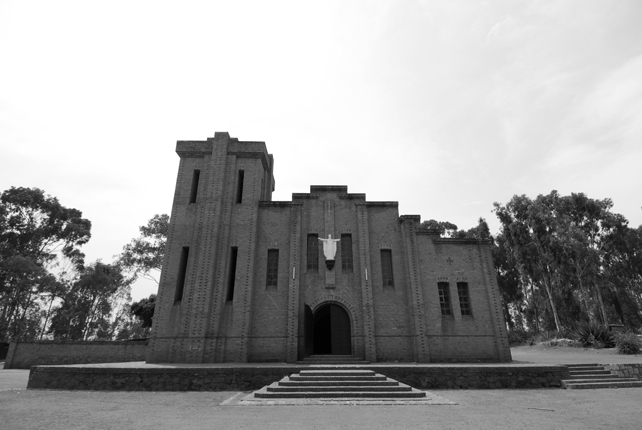
|
The Nyarubuye site is located in Eastern Province. Click on the image for a slideshow of photographs. All photographs © 2002-2008 Jens Meierhenrich except Photographs 2-12 © Kigali Memorial Centre. |

|
The Nyarubuye site is located in Eastern Province. Click on the image for a slideshow of photographs. All photographs © 2002-2008 Jens Meierhenrich except Photographs 2-12 © Kigali Memorial Centre. |
In a courtyard at this religious complex in the rural southeast of Rwanda, two small slabs of stone have been worn smooth, not by rainfall over the past century but by the steady movements of killers sharpening their machetes during the calamitous spring of 1994.
Prior to the genocide, the huge, cavernous church and adjacent convent were centers for worship. Over three days between April 15 and 17, however, thousands of Tutsi civilians—the precise number is uncertain—who had fled to the parish seeking safety fell victim to attacks led by the local political leader, Sylvestre Gacumbitsi.
According to the Trial Judgment rendered by the International Criminal Tribunal for Rwanda, “[O]n 15 April 1994, Sylvestre Gacumbitsi took part in the attack against Nyarubuye Parish, where many Tutsi refugees and Hutu had gathered. Sylvestre Gacumbitsi arrived at the parish in a convoy of vehicles carrying communal policemen and Interahamwe [militia]. The attackers wore clothing attributed to the Interahamwe. They were armed with machetes and other traditional or crafted weapons, and with guns and grenades that they used during the attack. [...] Shortly after arriving at the parish at about 3 p.m., Sylvestre Gacumbitsi killed Murefu, a Tutsi refugee who had gone up to him, and gave a signal for the massacres to commence. Sylvestre Gacumbitsi addressed the crowd through a megaphone and ordered Hutu refugees to separate themselves from the Tutsi. Some obeyed the orders. Communal policemen and Interahamwe attacked the refugees in the church building.”
These days, the parish has returned to its religious and educational roots to serve the community, though the convent halls show silent evidence from the betrayal of humanity enacted on these grounds. Three tables neatly display approximately one hundred skulls each, the gashes from violence clearly visible, the force of which cracked some of them open like eggshells. More tables display femurs and other major bones of the dead, while simple objects the people had brought with them to Nyarubuye—such as shoes, clothing, school books, Bibles, mattresses, and even beans—suggest the hopeful lives they had led.
In a memorial cemetery a few hundred yards below the church, a number of dignified tombs are each adorned with a simple cross. Further away, a 20-foot-square patch of land, partly sunken as if into a crater, contains a mass grave.
Local survivors long for improvements to appropriately honor their perished relatives, friends, and neighbors, and sadly, the wall of names thus far is almost blank.
Copyright © 2010 Jens Meierhenrich. All rights reserved.